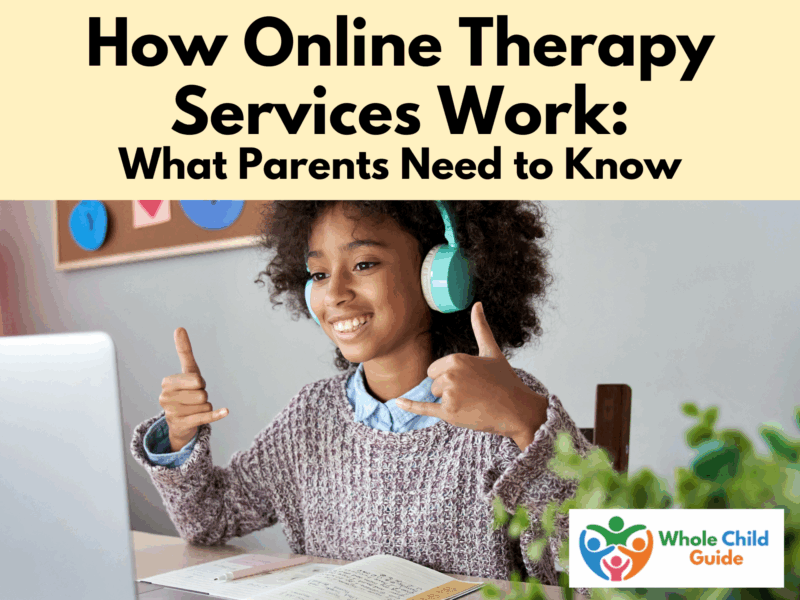
Therapy providers historically work in a clinic or therapy room in a facility, but in recent years, virtual therapy, or online therapy has become more widespread. This change in a treatment model is a lifesaver for some families. Online therapy, also called virtual therapy or teletherapy, has opened new doors for families seeking support for their child’s development, communication, emotional well-being, and sensory needs. What started as a solution during the pandemic has now become a trusted, flexible option for many parents.
You may have even used a teladoc option for your own health ailments. Have a sore throat but can’t get into the doctor’s office? A quick online virtual visit is a great option! But if you’re new to online therapy, you probably have questions: Do virtual sessions really work for kids? What will an online therapy session look like for my child? And how do I find someone licensed to help us in my state?
This guide will walk you through what online therapy for kids looks like, how to make it successful, and how to find trusted providers using Whole Child Guide.
What Is Online Therapy for Kids?
Online therapy involves working with a licensed pediatric therapist through a secure video platform. Depending on your child’s needs, this could include:
- Speech therapy (for everyday communication and language, articulation, or social communication)
- Occupational therapy (for motor skills, sensory processing, or daily routines)
- Counseling (for anxiety, behavior, emotional regulation, or life transitions)
- Parent coaching (support for caregivers in managing routines, meltdowns, or behavior)
Therapists use tools like games, visuals, interactive activities, and parent collaboration to make sessions fun, meaningful, and effective, even through a screen.
So What Happens During an Online Session?
A typical online therapy session lasts 30-60 minutes, depending on the age of the child and type of therapy. The therapist might:
- Use toys, videos, or visual schedules
- Share on-screen games or worksheets
- Guide you as the parent to help your child complete hands-on activities
- Focus on one or two specific goals each session
- Provide coaching, modeling, and progress updates
For younger children, the therapist may ask you to help set up activities, prompt your child, or assist with materials during the session.
Benefits of Online Therapy
- Convenience: Attend sessions from home, with no commute or rushed transitions.
- Consistency: Easier to stay on track with regular appointments.
- Comfort: Kids often feel more relaxed and regulated in their own environment.
- Access: You can work with licensed specialists, even if they’re not located nearby.
Challenges and What to Expect
Like anything new, virtual therapy takes some adjustment.
- Your child may need time to get used to the screen format.
- Younger kids may require your help during sessions.
- Reliable internet and a quiet space are important for success.
- Not every therapy goal can be met virtually. It all depends on the individual needs of the child. Your provider can help decide what’s best.
Tips for a Great Virtual Therapy Experience
- Create a calm, quiet space free of distractions.
- Have any needed materials ready ahead of time.
- Stick to a routine. Schedule therapy sessions at the same time, in the same spot, and using the same device.
- Talk with your therapist about what’s working and what’s not.
- Celebrate small wins together after each session!
Common Questions Parents Ask About Virtual Therapy
Does online therapy really work for kids?
Yes! Many kids make excellent progress online, especially with consistent attendance and a supportive caregiver nearby.
Is it effective for toddlers or preschoolers?
Yes, with help from a parent or caregiver during the session, young children can engage well in virtual therapy.
How do therapists keep kids engaged on screen?
Therapists use games, visuals, movement breaks, songs, and interactive tools to keep things fun and focused.
Will I need to help during sessions?
For younger children or OT sessions, yes, you’ll likely help guide the child, offer feedback, or support activities.
Is it covered by insurance?
Many providers accept insurance for virtual sessions. Always confirm with both the therapist and your insurance provider.
What if my child won’t sit still?
That’s okay! Therapists are trained to work flexibly. Sessions can include movement, breaks, or hands-on tasks.
Is online therapy private and secure?
Yes, therapists use HIPAA-compliant platforms designed for confidentiality and security.
How to Find a Licensed Online Therapy Provider
Therapists must be licensed in the state where your child lives, even for virtual sessions. That’s why using a platform like Whole Child Guide makes the search easier.
You can:
- Search by state, so you only see therapists licensed to work with your child
- Filter by service type, like speech therapy, OT, or counseling
- Choose “virtual sessions available” to find providers offering online therapy
- View provider bios and reach out directly through the platform
No more endless scrolling or dead-end searches—just a trusted tool to help you find what your child needs, fast.
Conclusion
Online therapy is a flexible, effective way to support your child’s growth, especially when in-person services aren’t an option. Whether your child needs support with communication, behavior, emotions, or daily routines, virtual therapy can bring real progress into your home. Use Whole Child Guide to find licensed online therapy providers in your state. Whether you’re looking for speech therapy, occupational therapy, or counseling, we make it easy to filter, connect, and take the next step toward supporting your child’s development.
